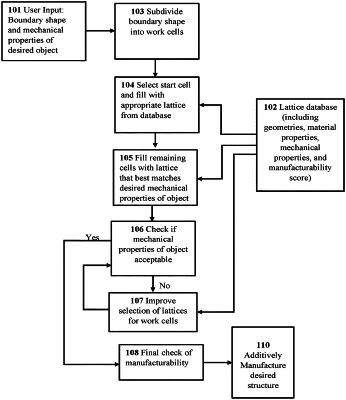| CPC B29C 64/386 (2017.08) [B29C 64/124 (2017.08); G06T 17/20 (2013.01); B33Y 10/00 (2014.12); B33Y 50/00 (2014.12)] | 11 Claims |

|
1. An additive manufacturing system for producing an object from a light-polymerizable resin, the additive manufacturing system comprising:
an additive manufacturing apparatus;
a processor; and
a memory comprising instructions which, when executed by the processor, cause the processor to control said additive manufacturing apparatus to perform operations comprising:
(a) receiving a boundary shape and a plurality of desired mechanical properties for said object;
(b) subdividing said boundary shape into a plurality of adjacent work cells;
(c) providing a plurality of lattices in a database, each lattice of the database including a geometry and a mechanical property;
(d) filling a first one of said work cells with a lattice from the database, the lattice selected based on a correspondence of the mechanical property of said lattice to said desired mechanical properties of said object;
(e) filling remaining ones of said work cells with lattices from said database to produce a filled boundary shape, each said lattice selected based on: (i) the correspondence of the mechanical property of said lattice to the desired mechanical properties of the object, and (ii) compatibility of adjacent lattices in adjacent work cells with one another; and
(f) producing said object by additive manufacturing from the light-polymerizable resin and the filled boundary shape.
|